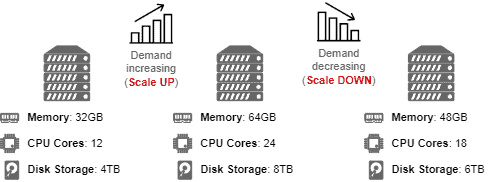1. 引言
在计算场景中,根据需求动态调整可用计算资源是一个历史悠久的需求。
在过去,增减计算资源是一项巨大的挑战。这些过程通常需要停止服务,修改软件配置,甚至更换本地服务器的硬件。
随着互联网的发展,云计算、虚拟化技术以及 X-as-a-Service 模式(如 IaaS、PaaS、SaaS)的兴起,使得资源的动态适配变得简单且自动化。在这样的背景下,可扩展性(Scalability) 和 弹性(Elasticity) 两个概念逐渐形成并不断发展。
本文将深入探讨这两个概念。我们先了解可扩展性的定义和实现方式,再介绍弹性的特点,最后通过对比帮助你更清晰地掌握它们之间的区别与联系。
2. 可扩展性(Scalability)
可扩展性指的是系统在负载增加时保持响应能力的能力。一个具有可扩展性的系统能够在不中断服务的前提下应对不断增长的工作负载。
更进一步地说,可扩展性关注的是系统如何适应未来不断增长的需求。虽然其定义中强调“应对增加的需求”,但也可以包括减少资源的过程。
2.1 垂直扩展与水平扩展
向系统中增减资源主要有两种方式:修改单个节点的资源数量,或修改节点数量。
- ✅ 垂直扩展(Vertical Scaling):指对单个节点的资源配置进行增减,包括:
- Scale Up:为节点增加内存、存储、网络带宽、CPU 核心等资源
- Scale Down:从节点中移除资源
下图展示了单节点的垂直扩展过程:

- ✅ 水平扩展(Horizontal Scaling):通过增减节点数量来调整系统资源,包括:
- Scale Out:新增节点以应对负载增长
- Scale In:移除节点以节省资源
下图展示了多节点系统的水平扩展过程:

2.2 可扩展性的其他维度
除了常见的负载可扩展性,还有一些其他维度的可扩展性值得关注:
- 异构扩展(Heterogeneous Scalability):系统支持来自不同厂商的节点和组件
- 代际扩展(Generation Scalability):系统能用新一代组件替换旧组件
- 管理扩展(Administrative Scalability):系统能支持越来越多的用户或客户
- 功能扩展(Functional Scalability):系统能支持越来越多的新功能实现
3. 弹性(Elasticity)
弹性指的是系统应对工作负载变化的能力。
弹性系统的核心理念是:根据当前负载动态调整资源,既不过度分配,也不资源不足。
与可扩展性不同的是,弹性系统更关注短期、突发性的工作负载变化。它不是基于中长期的预测,而是实时或近实时地响应负载波动。
例如:一个电商平台平时有 X 个访问量,但在促销期间突然激增到 4X。弹性系统会自动触发扩容机制,临时增加资源以应对高并发,促销结束后再自动缩容。
下图展示了弹性系统应对突发流量的示意图:

3.1 资源过度配置与不足配置
弹性系统的目标是在资源浪费与资源不足之间找到平衡点。但在实际操作中,可能会出现以下两种问题:
- ✅ 过度配置(Over-provisioning):系统分配了超过当前负载所需的资源,造成浪费(尤其在按使用量计费的云环境中)
- ❌ 不足配置(Under-provisioning):系统资源不足以应对当前负载,导致服务延迟甚至拒绝服务
因此,合理配置弹性策略,比如设置自动扩容/缩容的阈值、冷却时间等,是避免上述问题的关键。
4. 系统化对比
| 对比维度 | 可扩展性(Scalability) | 弹性(Elasticity) |
|---|---|---|
| 资源目标 | 超前满足未来需求 | 实时匹配当前需求 |
| 场景依据 | 基于中长期负载预测 | 基于短期或突发负载变化 |
| 执行方式 | 通常由管理员手动或定时触发 | 通常由监控系统自动触发 |
| 关键操作 | Scale Up、Scale Out | Scale Up、Scale Down、Scale Out、Scale In |
5. 总结
本文系统地讲解了可扩展性与弹性的概念、实现方式及关键区别。
- ✅ 可扩展性 更关注中长期负载增长,通过预判未来需求来调整资源
- ✅ 弹性 更关注实时负载波动,通过自动机制动态调整资源
两者相辅相成,是现代云原生架构和分布式系统中不可或缺的能力。掌握它们的原理和应用场景,有助于我们在设计高可用、高性能系统时做出更明智的决策。
⚠️ 踩坑提醒:在实际部署中,很多人会把“弹性”误认为是“自动扩容”,其实缩容同样重要。过度依赖扩容而不合理设置缩容策略,很容易导致资源浪费和成本飙升。